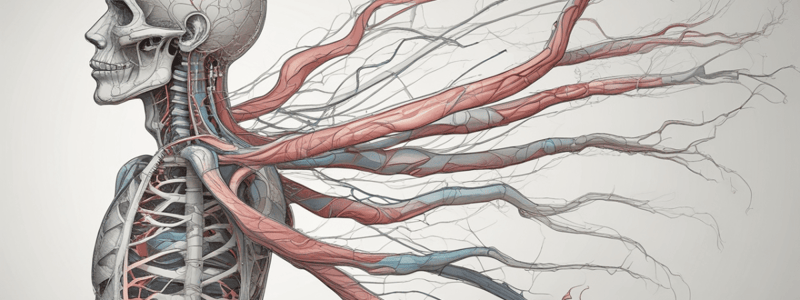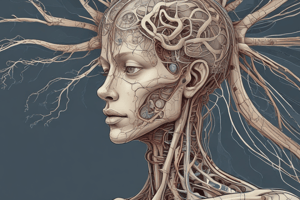Podcast
Questions and Answers
Which part of the brain is divided into the midbrain, pons, and medulla?
Which part of the brain is divided into the midbrain, pons, and medulla?
- Cerebellum
- Forebrain
- Brain stem (correct)
- Cerebrum
What is the primary function of afferent neurons?
What is the primary function of afferent neurons?
- To process information in the Peripheral Nervous System
- To carry information out of the Central Nervous System
- To carry information into the Central Nervous System (correct)
- To regulate the activity of the Cerebellum
Which of the following is NOT a part of the Central Nervous System?
Which of the following is NOT a part of the Central Nervous System?
- Ganglia (correct)
- Spinal cord
- Cerebellum
- Brain
What is the term for the embryonic structure that develops into the cerebrum?
What is the term for the embryonic structure that develops into the cerebrum?
What is the primary function of spinal nerve roots?
What is the primary function of spinal nerve roots?
What is the characteristic of the distal parts of nerves?
What is the characteristic of the distal parts of nerves?
What is the main difference between the cranial nerves and the spinal nerves?
What is the main difference between the cranial nerves and the spinal nerves?
Which part of the brain is NOT a part of the brain stem?
Which part of the brain is NOT a part of the brain stem?
What is the function of the somas of neurons in the Peripheral Nervous System?
What is the function of the somas of neurons in the Peripheral Nervous System?
What is the characteristic of the proximal parts of nerves?
What is the characteristic of the proximal parts of nerves?
Which of the following is NOT a part of the brain?
Which of the following is NOT a part of the brain?
What is the main difference between efferent neurons and afferent neurons?
What is the main difference between efferent neurons and afferent neurons?
What is the main function of the Peripheral Nervous System?
What is the main function of the Peripheral Nervous System?
What is the term for the nerves that exit the skull?
What is the term for the nerves that exit the skull?
Which part of the brain is divided into left and right cerebral hemispheres?
Which part of the brain is divided into left and right cerebral hemispheres?
What is the main function of ganglia in the Peripheral Nervous System?
What is the main function of ganglia in the Peripheral Nervous System?
What is the embryonic structure that develops into the pons, medulla, and cerebellum?
What is the embryonic structure that develops into the pons, medulla, and cerebellum?
What is the characteristic of nerves as they travel from their proximal origin to their distal ends?
What is the characteristic of nerves as they travel from their proximal origin to their distal ends?
Flashcards are hidden until you start studying
Study Notes
Structure of the Nervous System
- The nervous system is divided into two main structural parts: the Central Nervous System (CNS) and the Peripheral Nervous System (PNS)
- The CNS consists of the brain and spinal cord
- The brain is divided into several parts, including:
- Cerebrum (largest part of the brain, divided into left and right cerebral hemispheres)
- Brain stem (connects the cerebrum to the spinal cord, divided into midbrain, pons, and medulla)
- Cerebellum (located behind the brain stem)
Brain Development
- Brain structures are referred to by their embryonic names:
- Forebrain (becomes cerebrum)
- Midbrain (becomes midbrain)
- Hindbrain (becomes pons, medulla, and cerebellum)
Peripheral Nervous System
- Consists of two types of structures: nerves and ganglia
- Nerves are long stringy structures that carry axons of neurons
- Ganglia are lumps attached to nerves, containing the somas of neurons
- Peripheral nervous system is divided into:
- Cranial nerves (exit the skull)
- Spinal nerves (exit the spinal cord)
Nerve Types
- Afferent neurons (carry information into the CNS)
- Efferent neurons (carry information away from the CNS)
Nerve Structure
- Spinal nerves form from spinal nerve roots (afferent neurons in the back, efferent neurons in the front)
- Nerves branch repeatedly as they travel from their proximal origin to their distal ends
- Proximal parts of nerves are visible to the naked eye, while distal parts become microscopic
Structure of the Nervous System
- The nervous system is composed of two main parts: Central Nervous System (CNS) and Peripheral Nervous System (PNS)
- CNS consists of the brain and spinal cord
- Brain is divided into cerebrum, brain stem, and cerebellum
- Cerebrum is the largest part of the brain, divided into left and right cerebral hemispheres
- Brain stem connects the cerebrum to the spinal cord, divided into midbrain, pons, and medulla
- Cerebellum is located behind the brain stem
Brain Development
- Forebrain develops into cerebrum
- Midbrain develops into midbrain
- Hindbrain develops into pons, medulla, and cerebellum
Peripheral Nervous System
- Consists of nerves and ganglia
- Nerves are long stringy structures carrying axons of neurons
- Ganglia are lumps attached to nerves, containing somas of neurons
- PNS is divided into cranial nerves and spinal nerves
- Cranial nerves exit the skull
- Spinal nerves exit the spinal cord
Nerve Types
- Afferent neurons carry information into the CNS
- Efferent neurons carry information away from the CNS
Nerve Structure
- Spinal nerves form from spinal nerve roots
- Afferent neurons are located in the back of spinal nerve roots, efferent neurons in the front
- Nerves branch repeatedly from proximal origin to distal ends
- Proximal parts of nerves are visible to the naked eye, distal parts become microscopic
Structure of the Nervous System
- The nervous system is composed of two main parts: Central Nervous System (CNS) and Peripheral Nervous System (PNS)
- CNS consists of the brain and spinal cord
- Brain is divided into cerebrum, brain stem, and cerebellum
- Cerebrum is the largest part of the brain, divided into left and right cerebral hemispheres
- Brain stem connects the cerebrum to the spinal cord, divided into midbrain, pons, and medulla
- Cerebellum is located behind the brain stem
Brain Development
- Forebrain develops into cerebrum
- Midbrain develops into midbrain
- Hindbrain develops into pons, medulla, and cerebellum
Peripheral Nervous System
- Consists of nerves and ganglia
- Nerves are long stringy structures carrying axons of neurons
- Ganglia are lumps attached to nerves, containing somas of neurons
- PNS is divided into cranial nerves and spinal nerves
- Cranial nerves exit the skull
- Spinal nerves exit the spinal cord
Nerve Types
- Afferent neurons carry information into the CNS
- Efferent neurons carry information away from the CNS
Nerve Structure
- Spinal nerves form from spinal nerve roots
- Afferent neurons are located in the back of spinal nerve roots, efferent neurons in the front
- Nerves branch repeatedly from proximal origin to distal ends
- Proximal parts of nerves are visible to the naked eye, distal parts become microscopic
Structure of the Nervous System
- The nervous system is composed of two main parts: Central Nervous System (CNS) and Peripheral Nervous System (PNS)
- CNS consists of the brain and spinal cord
- Brain is divided into cerebrum, brain stem, and cerebellum
- Cerebrum is the largest part of the brain, divided into left and right cerebral hemispheres
- Brain stem connects the cerebrum to the spinal cord, divided into midbrain, pons, and medulla
- Cerebellum is located behind the brain stem
Brain Development
- Forebrain develops into cerebrum
- Midbrain develops into midbrain
- Hindbrain develops into pons, medulla, and cerebellum
Peripheral Nervous System
- Consists of nerves and ganglia
- Nerves are long stringy structures carrying axons of neurons
- Ganglia are lumps attached to nerves, containing somas of neurons
- PNS is divided into cranial nerves and spinal nerves
- Cranial nerves exit the skull
- Spinal nerves exit the spinal cord
Nerve Types
- Afferent neurons carry information into the CNS
- Efferent neurons carry information away from the CNS
Nerve Structure
- Spinal nerves form from spinal nerve roots
- Afferent neurons are located in the back of spinal nerve roots, efferent neurons in the front
- Nerves branch repeatedly from proximal origin to distal ends
- Proximal parts of nerves are visible to the naked eye, distal parts become microscopic
Studying That Suits You
Use AI to generate personalized quizzes and flashcards to suit your learning preferences.





